When Worlds (don't) collide - Sci-fi and Politics in 1950's
 Submitted by HALfie on
Submitted by HALfie on
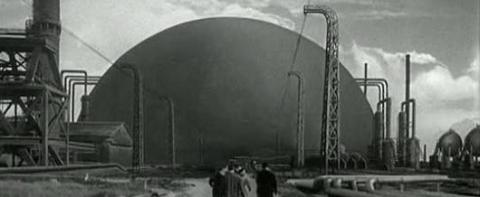
Introduction
The term science fiction was conied in the 1920s by the American publisher Hugo Gernsback that was one of the first in using the term "science fiction": a genre of fiction dealing with imaginative content such as futuristic settings, futuristic science and technology, space travel, time travel, faster than light travel, parallel universes and extraterrestrial life.
The early days of the genre was influenced by literature, art and also politics. The last one was mainly influential on the genre leading to a specific cinematic trend later.
Sci Fi can be political in many ways. In a dark and satirical way, like the classic “1984” that inspired the movie “Big Brother” (Allan Dwan -1923), which is a tale about the capability of totalitarian governments and its impacts on individuality and identity itself.
In other terms, Sci-fi sceneries represents speculations on our own political climate, or simulating imagined civilizations or theories that are not possible in our world.
Whatever is, science fiction genre looks to the future but it also reflects the time when it was created.
To give an example: one of the earliest works of modern science fiction, H. G. Wells’s “The Time Machine”, is an extrapolation of the class structure of the United Kingdom of his time, an extreme form of Social Darwinism that described how human beings have evolved into two different species based on their social classes.
Paraphrasing a famous film title: Sci-fi and Politics are different “worlds” that don’t collide, getting along perfectly.
In 1902 Georges Melies shot “A Trip To The Moon” (one of the first documented sci-fi films) and since then the man has projected himself towards the “unknown”simply using imagination. While some genres have blossomed and faded with time, sci-fi has always mantained a strong presence on the big screen.
“Metropolis” (Frizt Lang - 1927) was certainly the first remarkable screen science ficti on movie, it depicted a society in which social classes were strict and marked, proving the growing gap among aristocracy and the proletariat. Certainly influenced by the atmosphere of the short lived Weimar Republic (German first democracy), distributors were concerned to be stigmatized as “communist”.
on movie, it depicted a society in which social classes were strict and marked, proving the growing gap among aristocracy and the proletariat. Certainly influenced by the atmosphere of the short lived Weimar Republic (German first democracy), distributors were concerned to be stigmatized as “communist”.
1950’s - The Golden Age of Science Fiction Films
Nonetheless the proliferation of science fiction films took place in post-World War II film history.
According statistics, 500 film features and shorts made between 1948 and 1962 can be indexed under the broad heading of science fiction. In the history of motion pictures, any other genre has developed and multiplied so rapidly in so brief period. Much of the production was in a low-budget form targeted at a teenage audience. They drew upon political themes or public concerns of the day, including depersonalization, infiltration, or fear of nuclear weapons. Invasion was a common theme, as were various threats to humanity.
Indeed the United States tested the first atomic bomb in July 1945 at Alamogordo (NM) and just a month later, they used the new technology to annihilate Hiroshima and Nagasaki.
After WWII, images of the slaughter in Japan accompanied by the unease about a growing Communist presence in the East created a climate of uncertainty and possible conflict.
Summarising, Science fiction movies were aimed at distracting viewers from their pedestrian lives and calming the anxieties generated by a shadowy, high-stakes political rivalry.
Generally speaking, 50's science fiction movies can be classified in the following subgenres: space travels and space invaders (aliens); monsters and mutants are considered like “horror movies”.
Space travels
In response to a growing interest in rocketry and space exploration, space travel films gained popularity although they were very poor in screenplays and suffering from bad acting and trivial dialogues.
In the early 1950s, it is important to mention two films:
- “Destination Moon” (Irving Pichel -1950) 
It predicted the conquest the moon and thus begins the use of space as a political battlefield.
- “Rocketship X-M” (Kurt Neumann - 1950)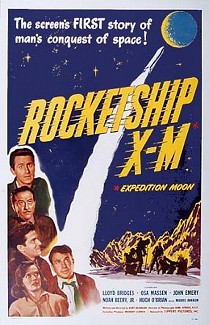
As a “pioneer movie”, there were used realistic spacesuits and “special effects”; nonetheless it should be noted for its use of the space as a battleground with the USSR, constantly reminding the Cold War political climate.
Space Invaders Films in the Cold War Era
Most of the sci-fi films of the 1950s portrayed the human race attacked and destroyed by mysterious and hostile forces. Cold War politics undoubtedly contributed to suspicion and paranoia of anything "other" or "un-American."
Allegorical science fiction films reflected the collective unconscious, threats and evils that surrounded us (where alien forces were often a metaphor for Communism), and the dangers of aliens taking over our minds and territory. It was a tale told to illustrate how scientists had foolishly meddled with things that should have been left alone and caused further catastrophe.
UFO sightings and reports of flying saucers or strange visitors from outer space found their way into Hollywood features as allegories of the Cold War.
-“The Day The Earth Stood Still” (Robert Wise -1951) tells about an alien who landed on the planet Earth in order to bring an important message for the future of the human beings.
Full of innovative design, “The Day the Earth Stood Still” was a movie that pushed its audience to think of themselves as humans rather than Americans. The sentence “Klaatu Barada Nikto” remained famous in the cinema history although there has never been a precise translation.
- “The Thing From Another World” (Christian Nyby - 1951) is inspired by the novel “Who Goes There?” (John W. Campbell, Jr.) and it was faithfully remade by J. Carpenter in 1982 (“The Thing”). 
Movie narrates the story of the discovery of a frozen block of ice containing an alien life form, buried at a 'flying saucer' crash site near a remote Arctic outpost. Accidentally the creature has brought to life and when the monstrous creature finally appeared, it was destroyed after being eventually electrocuted.
Undoubtely the most awkward element of “The Thing from Another World” is the pro-military, anti-science ending where a reporter's radio warning broadcast: "Watch the skies! Everywhere. Keep looking. Keep watching the skies!" seems to be a warning to the future soldiers to get ready.
- “When Worlds Collide” (Rudolph Mate - 1951), from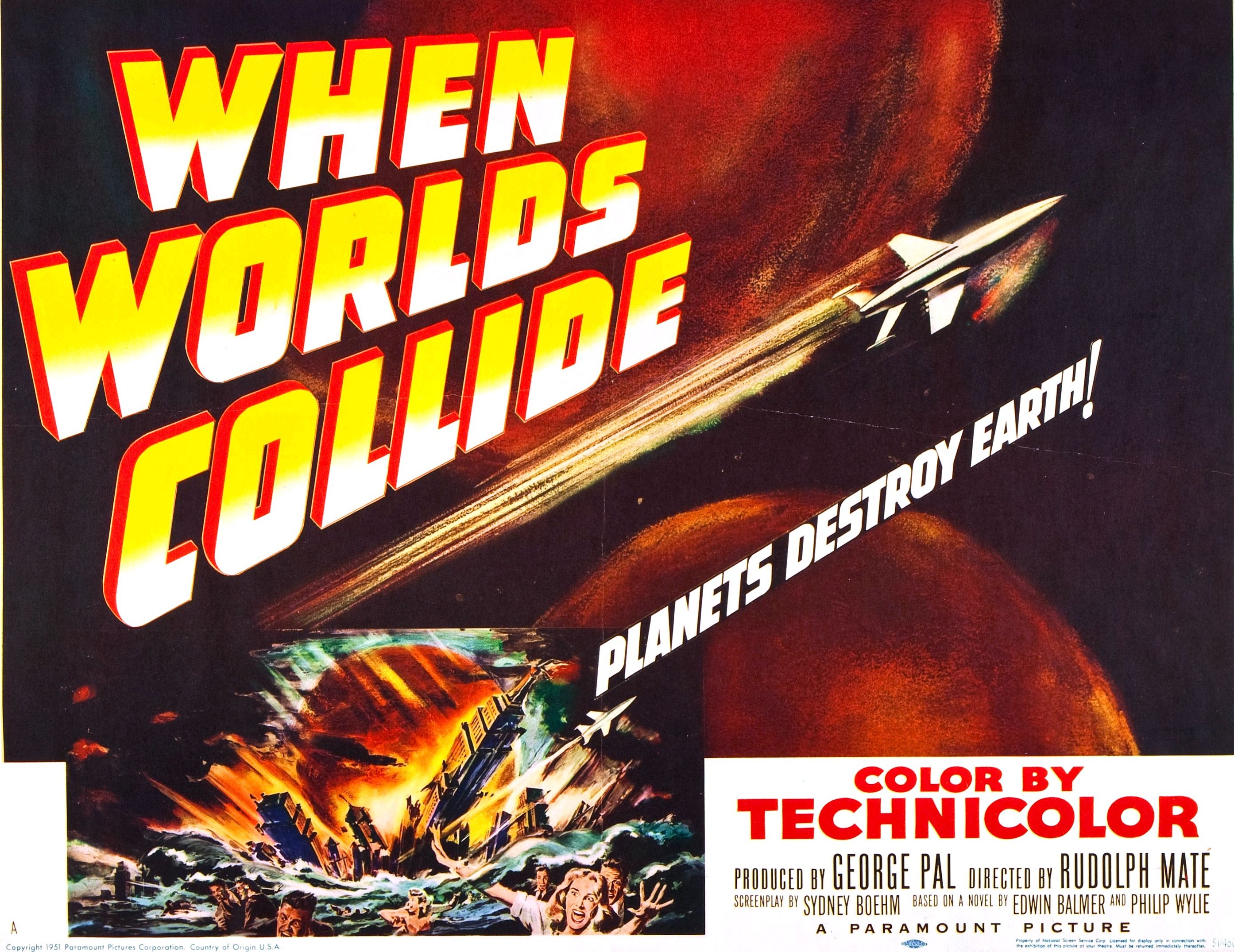 an original novel by Philip Wylie and Edwin Balmer, the plot concerns the desperate effort to build a 'Noah's-Ark'-like spaceship to evacuate a few chosen survivors to fly to Bellus' satellite Zyra and colonize it in order to abandon the Earth fated to the incoming destruction.
an original novel by Philip Wylie and Edwin Balmer, the plot concerns the desperate effort to build a 'Noah's-Ark'-like spaceship to evacuate a few chosen survivors to fly to Bellus' satellite Zyra and colonize it in order to abandon the Earth fated to the incoming destruction.
Some critics has recognized this movie as that kind of film where a heroic scientist confronts a catastrophe supported by science, in any case it could be interpreted as a parable of nuclear age of the ’50.
- “It Came From Outer Space” (Jack Arnold - 1953) adapted fro m an original Ray Bradbury’s “The Meteors”, in spite of the general trend, it brought an anti-conformist and anti-McCarthy message describing benign aliens. By cloning the identities of citizens, alien turned them into host bodies in order to repair their spaceship.
m an original Ray Bradbury’s “The Meteors”, in spite of the general trend, it brought an anti-conformist and anti-McCarthy message describing benign aliens. By cloning the identities of citizens, alien turned them into host bodies in order to repair their spaceship.
- The low-budget, cult classic film “Invaders from Mars” (William Cameron Menzies - 1953) [remade in 1986], is one of the earliest films of its kind to be filmed in color.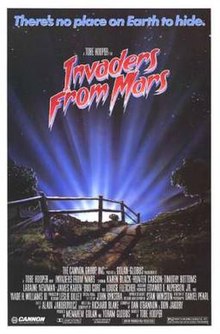
The story is narrated from the point of view of young boy who dreamt of a Martian flying saucer landed in a nearby field and of the menacing Martians; the film ended with the opening sequence of the nightmare coming true.
This film explores that kind of fear generated by aliens who take over the bodies and minds of good people, making it impossible to distinguish between us and them.
- “The War of the Worlds” (Byron Haskin - 1953) is inspired by the H. G. Wells’s novel (1898). 
A large meteorite-spaceships come crashing down all over the Earth, the Martians disintegrate everything they meet in their way using a heat-ray.
Fortunately, Martians have no defenses against the Earth's viruses and bacteria to which humanity has long since become immune, so that they are fated to die.
- “This Island Earth” (Joseph Newman – 1955), was based o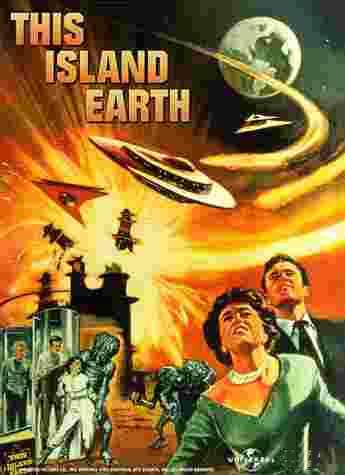 n the novel “The Alien Machine” by Raymond F. Jones. Aliens seeked uranium and the knowledge of noted Earth scientists to save their planet from destruction in their inter-planetary war against the evil Zahgons.
n the novel “The Alien Machine” by Raymond F. Jones. Aliens seeked uranium and the knowledge of noted Earth scientists to save their planet from destruction in their inter-planetary war against the evil Zahgons.
A good sample of prediction of the Reagan era obsession with a protective space-based shield.
- The most brilliant film is the "Invasion of the Body Snatchers” (Don Siegel - 1956). A small-town doctor realized that the population of his community is being replaced by alien duplicates that act as emotion-less human clones, to conquest the entire planet.
It represents the perfect symbol of post-McCarthy’s ideology and can be interpreted as a demonstration of the dangers of communist infiltration and brainwashing, or the pressures exerted to bring conformity to American society.
The “Invasion of Body Snatchers” exploited the Red paranoia existing in the 50s and warned about the dangers of an automaton existence and mindless apathy.
-“Village of the Damned” (Wolf Rilla - 1960) based on John Wyndam's novel entitled “The Midwich Cuckoos”.
A strange and mysterious force leaves the women of a village pregnant. Babies who are born, look normal but it doesn't take long to realize that the kids are not human and extremely dangerous.
Monsters and Mutants
The 'Monster Movies' of the 1950s are a clear attempt to explore the 'shadow' or the 'dark' side of science, they may reflect the archetypal interest in exploring the threats to existing forms of social and political order.
The cultural expression of a form of apocalypticism which pervaded American (and British) cinema in the 1950s, and which resurfaced in the disaster movies of the mid 1970s – “Earthquake”, “The Towering Inferno”, “The Swarm”, etc.
According the psychological view, horror and the sci-fi movies rely on the projection of psychic material from the unconscious to elicit its meaning and value, or in a Jungiam vision, they‘d represented universal symbols of transformation that evokes mythic concepts such as: heroes and the contexts of death and rebirth, hold fascinating stories for the audiences.
The aberrant monsters were the direct result of man's interference with nature, atomically created from nuclear experiments or A-bomb accidents, more terrifying in conception than execution.
There were many examples of low-budget 50s films about the horrors of the Atomic Age:
-“The Beast From 20,000 Fathoms” (Eugene Lourie's 1953), based on a Ray Bradbury short story; this involves the accidental awakening of a 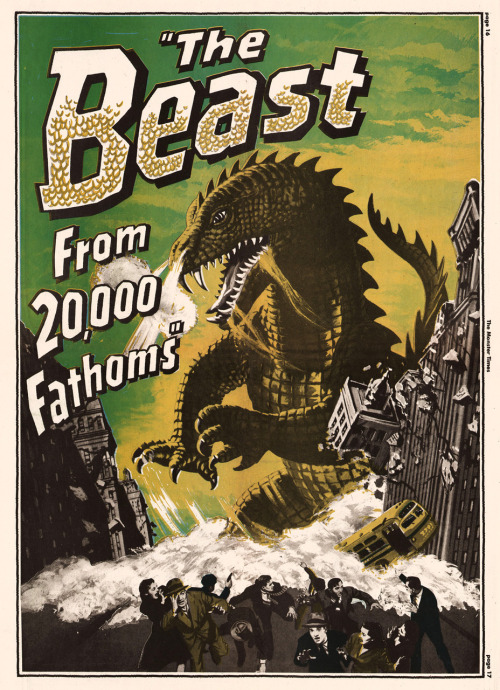 carnivorous dinosaur; after emerging from the sea, Rhedosaurus wreaks havoc from city to city until he arrives at Manhattan Island, where it was killed by a radio-active isotope fired into a wound in its throat and burned in a roller-coaster bonfire; this movie can be considered a precursor to the 1954 Gojira or “Godzilla” monster, and it was the first film to feature a giant creature awakened or mutated by a nuclear bomb and at the same time one of the top-grossing movies of 1953 ($5 million from a budget of $250,000), incouraging the studios to invest in further monster movies.
carnivorous dinosaur; after emerging from the sea, Rhedosaurus wreaks havoc from city to city until he arrives at Manhattan Island, where it was killed by a radio-active isotope fired into a wound in its throat and burned in a roller-coaster bonfire; this movie can be considered a precursor to the 1954 Gojira or “Godzilla” monster, and it was the first film to feature a giant creature awakened or mutated by a nuclear bomb and at the same time one of the top-grossing movies of 1953 ($5 million from a budget of $250,000), incouraging the studios to invest in further monster movies.
-“Them!“ (Go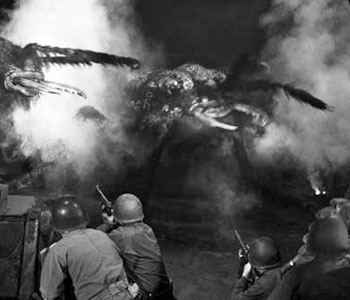 rdon Douglas - 1954) is a scary film that launched the gigantic killer bug, B-movie sub-genre. Nuclear testing in the desert causes the growth of gigantic mutant ants that terrorize American south-west cities; scientists and the U.S. Army try to find a way to control their spread of death and destruction.
rdon Douglas - 1954) is a scary film that launched the gigantic killer bug, B-movie sub-genre. Nuclear testing in the desert causes the growth of gigantic mutant ants that terrorize American south-west cities; scientists and the U.S. Army try to find a way to control their spread of death and destruction.
- “Kronos” (Kurt Neumann - 1957) is a low-bu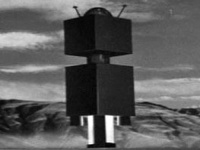 dget sci-fi thriller narrating about a giant, electrical energy-sucking alien machine/robot from outer space.
dget sci-fi thriller narrating about a giant, electrical energy-sucking alien machine/robot from outer space.
“The Incredible Shrinking Man” (Jack Arnold - 1957), it was another of the atomic-era films that featu red amazing special effects of a man miniaturized by glittery particles of radioactive mist (atomic nuclear fallout), and then terrorized by an oversized cat and giant black spider in a cellar.
red amazing special effects of a man miniaturized by glittery particles of radioactive mist (atomic nuclear fallout), and then terrorized by an oversized cat and giant black spider in a cellar.

“The Amazing Colossal Man” (Bert Gordon's - 1957) questioned the damaging effects of technology, nuclear energy, and radiation through the character of an Army officer who grew to a height of 160 feet due to radioactive poisoning.
"The Experiment of Doctor K -The Fly” (Kurt Neumann - 1958) adapted from George Langelaan's short story. A scientist has a horrific accident when he tries to use his newly invent ed teleportation device. Unknowingly, a fly was in the device during his experiments and the scientist is transformed into a half human / half fly creature the film was followed by two sequels (“Return of the Fly” (1959) and “Curse of the Fly” (1965)) and director David Cronenberg's great remake “The Fly” (1986) years later.
ed teleportation device. Unknowingly, a fly was in the device during his experiments and the scientist is transformed into a half human / half fly creature the film was followed by two sequels (“Return of the Fly” (1959) and “Curse of the Fly” (1965)) and director David Cronenberg's great remake “The Fly” (1986) years later.
- “The Blob” (Irvin Yeaworth - 1958) 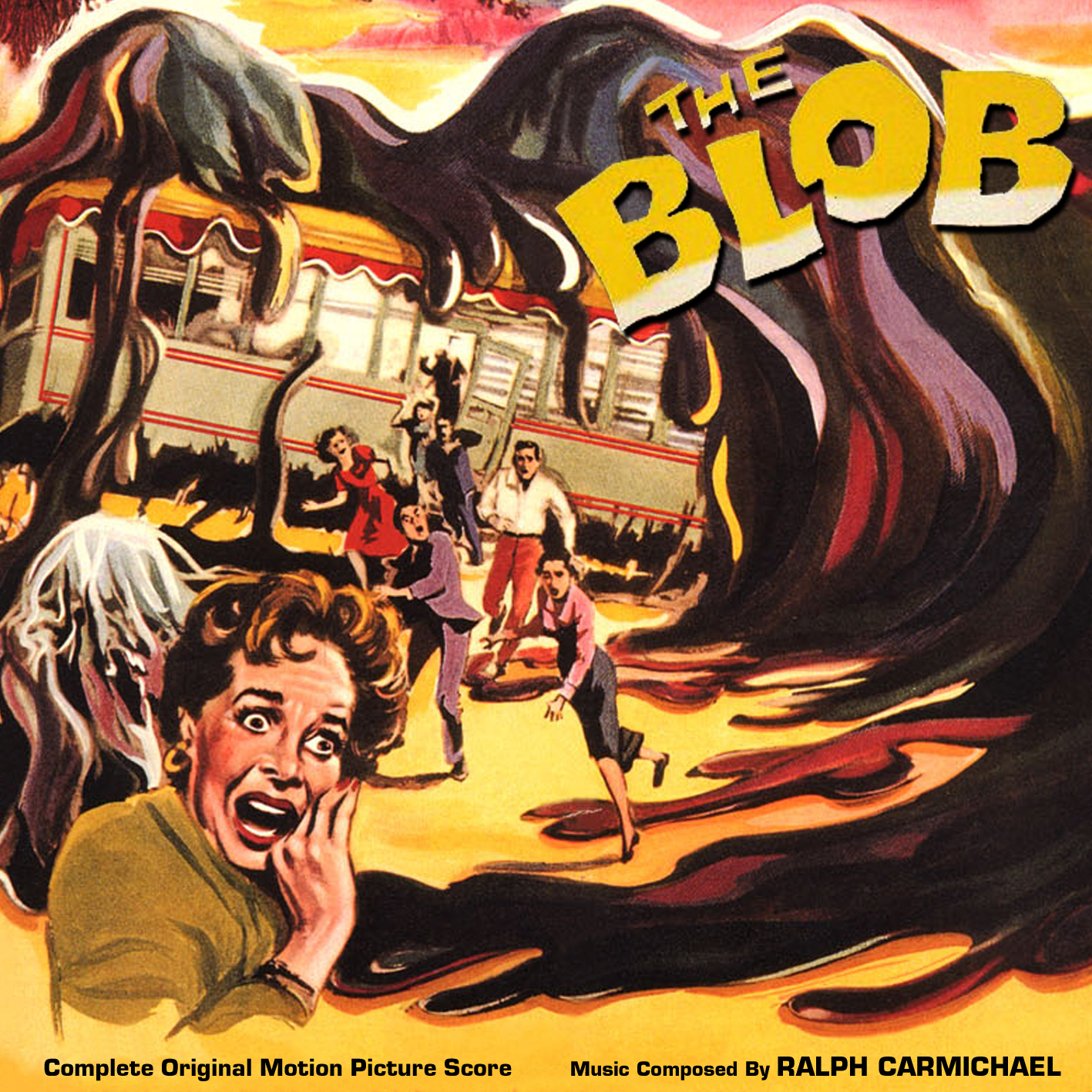
An alien life-form lands on Earth and consumes everything in its path as it grows and grows. The Blob spreads from town to town and just keeps getting bigger.
- “Forbidden Planet” (Fred McLeod Wilcox - 1956). The studio-bound film inspired the look of many future films and works, notably TV's Star Trek by Gene Roddenberry and Star Wars creator George Lucas, and it was shot in CinemaScope and color.
Star Trek by Gene Roddenberry and Star Wars creator George Lucas, and it was shot in CinemaScope and color.
It told the story of a journey of the astronauts of United Planets Cruiser C57D (led by commanding officer Leslie Nielsen in one of his earliest roles) to a distant planet named Altair-IV. There, they investigated the fate of a colony planted years before.
Conclusions
Generally speaking, these movies have been underestimated as trivial tales where the “monster” is simply portrayed as “something to be repressed or destroyed by the forces in order”.
Some critics are more agreed in not considering them just fables and allegories in order to demystify the enemy; these narratives are more complex than this and considering just one side of the coin might be an erroneus conclusion.
The Sci-fi genre was concerned as much with "developments within American society as with the threat of Russian invasion", with the prevalence of forms of 'Fordist' social regulation and engineering, (relying on scientific-technical rationality) which accompanied the emergence of a regulated and ordered mass consumer society.
In other words, American society was deeply and briefly changing in a tumultous way requiring new rules to manage the change.
Originally, “model T” invented by Henry Ford was a free expression of entrepreneurial mindsets, representing an unprecedented revolution in the industrial manifacturing and introducing concepts such as “assembly lines” and “fragmentation” of the production. Later the intensive “workers exploitation” in in manifacturing sector opened to “strikes” and to the “class struggle”.
As a consequence, the “Invasion” and “Monsters” movies of 1950, shouldn’t be interpreted just as the right wing hysteria and anti-communist rhetoric, but mostly as a urgent need of authoritarian resistance to the anarchy of communism.
Looking in detail at the plots, narrative structures and forms of characterisation of such films show a barely-concealed preoccupation with social and political issues which were haunting America in the 1950s.
A film like the "Invasion of the Body Snatchers” can be read as:
a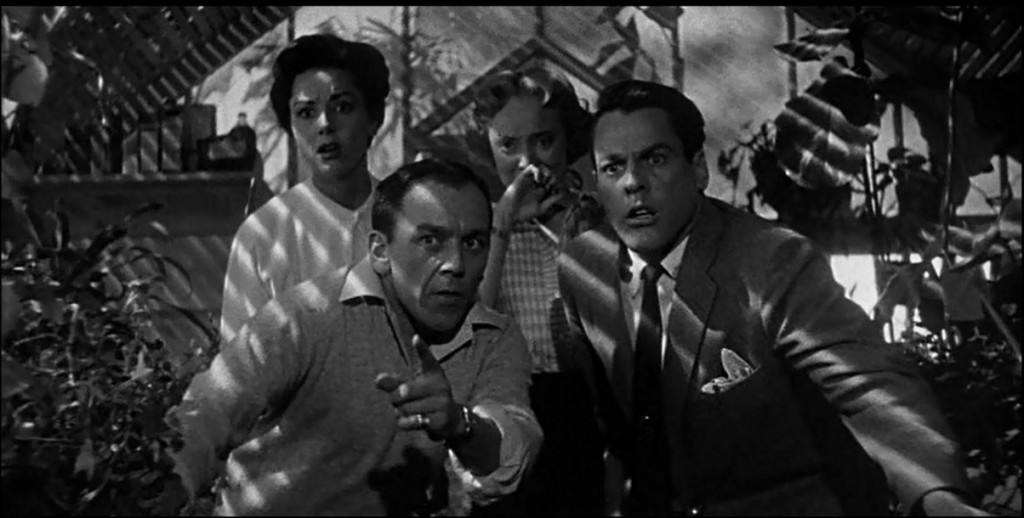 deeply concern with a growing standardization spreading through America, a conformity intended as collective forms of social organization associated with Fordism such as social welfare programmes.
deeply concern with a growing standardization spreading through America, a conformity intended as collective forms of social organization associated with Fordism such as social welfare programmes.
These forms of social organization could be read as a threat to American values, particularly American individualism and paradoxically they were indistinguishable from communism, so that it was a concern shared by both the left and the right during the 1950s.
Whether viewed from the left or right, such readings emphasize the point that Fifties Horror B-and sci-fi movies are emphatically social and political narratives, with a social and political message behind the special effects.
According other critics, the new genre was successful because the concept of a horrific monsters had altered irrevocably between 1940 and 1950. The military action of WW2 had left: over 40 million dead, bereaved widows and homecoming soldiers had lived to many horror stories on their own so that they would never appreciate to rewatch themselves on the big screen. For these reasons, the post war brought a new breed of monsters and new ways to show horror.
After WWII, no nation could have engaged fully fledged armed conflicts although this didn’t halted other kind of operations in Asia (Korean and Vietnam); the standoff of the Cold War and the consequent fear became more unnerving than the war itself.
For this reason, the world could be never the same again. It meant that no matter how many soldiers, how skilled generals or how staunch supporters on the Home Front, only technology counted: it had to be the most powerful, destructive and deadlier, in few words: the atom bomb.
It’s no a coincidence if the first recorded sighting of a flying saucer occurred in 1947 followed by the famous Roswell incident. This was the clear symptom that people were confused and wary of the pace of technological change.
Agreed or not agreed on the previous theories, free to think that sci-fi and horror movies are just a mere entertainment, undoubtely politics and historical facts were influential on 1950’s movies production even decades later laying the groundwork for a further development of the genre to present day.
 [...] I can no longer sit back and allow Communist infiltration, Communist indoctrination, Communist subversion, and the international Communist conspiracy to sap and impurify all of our precious bodily fluids.[...]
[...] I can no longer sit back and allow Communist infiltration, Communist indoctrination, Communist subversion, and the international Communist conspiracy to sap and impurify all of our precious bodily fluids.[...]
from "Dr. Strangelove or: How I Learned to Stop Worrying and Love the Bomb"
